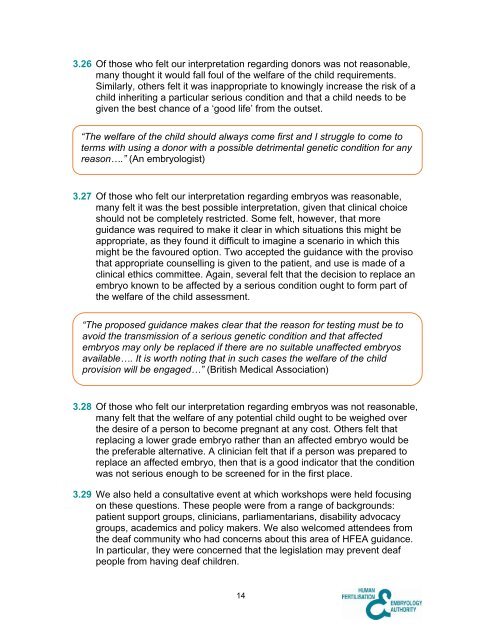Code of Practice 8th edition and consent forms consultation report
Code of Practice 8th edition and consent forms consultation report
Code of Practice 8th edition and consent forms consultation report
Create successful ePaper yourself
Turn your PDF publications into a flip-book with our unique Google optimized e-Paper software.
3.26 Of those who felt our interpretation regarding donors was not reasonable,<br />
many thought it would fall foul <strong>of</strong> the welfare <strong>of</strong> the child requirements.<br />
Similarly, others felt it was inappropriate to knowingly increase the risk <strong>of</strong> a<br />
child inheriting a particular serious condition <strong>and</strong> that a child needs to be<br />
given the best chance <strong>of</strong> a ‘good life’ from the outset.<br />
“The welfare <strong>of</strong> the child should always come first <strong>and</strong> I struggle to come to<br />
terms with using a donor with a possible detrimental genetic condition for any<br />
reason….” (An embryologist)<br />
3.27 Of those who felt our interpretation regarding embryos was reasonable,<br />
many felt it was the best possible interpretation, given that clinical choice<br />
should not be completely restricted. Some felt, however, that more<br />
guidance was required to make it clear in which situations this might be<br />
appropriate, as they found it difficult to imagine a scenario in which this<br />
might be the favoured option. Two accepted the guidance with the proviso<br />
that appropriate counselling is given to the patient, <strong>and</strong> use is made <strong>of</strong> a<br />
clinical ethics committee. Again, several felt that the decision to replace an<br />
embryo known to be affected by a serious condition ought to form part <strong>of</strong><br />
the welfare <strong>of</strong> the child assessment.<br />
“The proposed guidance makes clear that the reason for testing must be to<br />
avoid the transmission <strong>of</strong> a serious genetic condition <strong>and</strong> that affected<br />
embryos may only be replaced if there are no suitable unaffected embryos<br />
available…. It is worth noting that in such cases the welfare <strong>of</strong> the child<br />
provision will be engaged…” (British Medical Association)<br />
3.28 Of those who felt our interpretation regarding embryos was not reasonable,<br />
many felt that the welfare <strong>of</strong> any potential child ought to be weighed over<br />
the desire <strong>of</strong> a person to become pregnant at any cost. Others felt that<br />
replacing a lower grade embryo rather than an affected embryo would be<br />
the preferable alternative. A clinician felt that if a person was prepared to<br />
replace an affected embryo, then that is a good indicator that the condition<br />
was not serious enough to be screened for in the first place.<br />
3.29 We also held a consultative event at which workshops were held focusing<br />
on these questions. These people were from a range <strong>of</strong> backgrounds:<br />
patient support groups, clinicians, parliamentarians, disability advocacy<br />
groups, academics <strong>and</strong> policy makers. We also welcomed attendees from<br />
the deaf community who had concerns about this area <strong>of</strong> HFEA guidance.<br />
In particular, they were concerned that the legislation may prevent deaf<br />
people from having deaf children.<br />
14

















